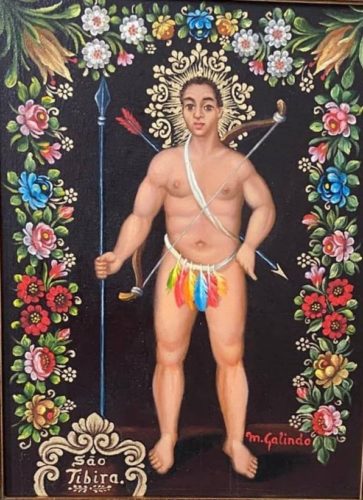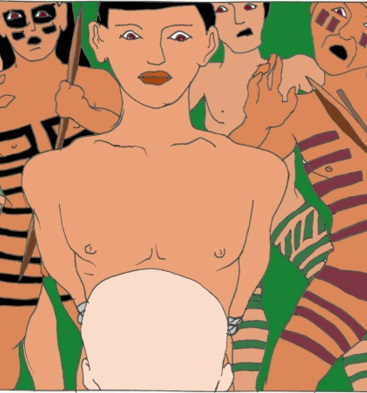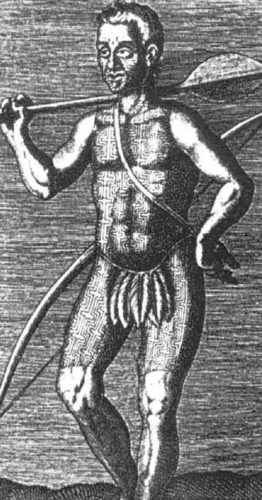Last Updated on December 6, 2024 by Kittredge Cherry

LGBTQ activists in Brazil launched a campaign for the sainthood of Tibira do Maranhão, the first gay martyr of Brazil. The indigenous man was baptized and then executed for sodomy by French missionaries on Dec. 8, 1614.
Tibira is the first documented case of a person killed for homosexuality in Brazil. He was a Tupinambá Indian living in Brazil’s northeastern coastal region of Maranhão. The word “tibira” referred to homosexuals in the Tupi language. LGBTQ activists in Brazil consider him a queer martyr and launched a campaign urging the church to canonize him as São Tibira (Saint Tibira) with Dec. 8 as his feast day.
The atrocity was buried for four centuries until it was rediscovered and highlighted by Grupo Gay da Bahia and its founder, anthropologist and historian Luiz Mott, professor at the Federal University of Bahia.
Tibira was cruelly executed by missionaries
A detailed record of the execution comes from French Capuchin friar Yves D’Evreux, who led the contingent of colonizing friars and wrote about it in his book “History of the Most Memorable Things Happened in Maranhão in the Years 1613-1614.” The martyrdom occurred a few months after the friars arrived in Maranhão. They were informed of a famous “tibira” among the indigenous population, so they ordered his capture, imprisonment, trial, baptism and death.

Tibira is found guilty of “sodomy” by the European friars in a detail of an illustration from the 2023 book “Heavenly LGBTQ+: Queer Icons from LGBTQ Life, Religion, and History” by Jan Haen, a Dutch artist and Roman Catholic priest. It is the sequel to his 2022 book “Heavenly Homos, Etc..”
They assembled the chiefs from all the nearby villages for the gruesome public spectacle. It was designed to “extinguish evil” and terrorize the native population into a supposedly “Christian” lifestyle that shunned same-sex attraction. The execution was not authorized by the Pope or the Inquisition.
Tibira did not die for being a heretic. On the day of his execution, before being killed, he was baptized and accepted the Christian faith “calmly and without sadness.” His baptismal name was Dimas, after the repentant thief who was crucified with Jesus.
After the baptism, a chief named Caruatapirã tried to comfort Tibera with his interpretation of the Christian resurrection. “You now have the opportunity to be comforted and not to be afflicted, because you are now a son of God…. When God sends someone to take your body, if you want to have long hair and a woman’s body in heaven rather than a man’s, ask God to give you the body of a woman and resurrect as a woman, and there in Heaven you will be with women and not men.”

Historical image of Tibira do Maranhão
This suggests that Tibira may have been genderqueer or transgender instead of gay. The colonial invaders probably lumped all LGBTQI+ people together as “sodomites,” but contemporary understanding reveals that “sodomites” were more diverse.
The missionaries executed Tibira by strapping him in front of a cannon and blowing him to pieces.
D’Évreux, his executioner, hurried to correct any queer-friendly interpretation. He wrote with cruel satisfaction, “His immortal soul was taken by angels to Heaven, for he died shortly after baptism, an infallible certainty of the salvation of that a whom God has granted such grace, as rare as the repentance of the good thief on the cross, to whom Jesus promised: Today you will be with me in Paradise!”
 This history is also discussed and put into broad historical context in the 2017 book “Gay Indians in Brazil: Untold Stories of the Colonization of Indigenous Sexualities” by anthropologists Estevão Rafael Fernandes and Barbara M. Arisi. It is also detailed in news reports from Vice.com , the BBC and and an article by Mott at Brazilian news site Correio.
This history is also discussed and put into broad historical context in the 2017 book “Gay Indians in Brazil: Untold Stories of the Colonization of Indigenous Sexualities” by anthropologists Estevão Rafael Fernandes and Barbara M. Arisi. It is also detailed in news reports from Vice.com , the BBC and and an article by Mott at Brazilian news site Correio.
LGBTQ promote Tibira’s sainthood
Starting a few years ago, Mott and other LGBTQ Brazilian activitists made headlines across Brazil by asking the Roman Catholic Church to canonize Tibira.
The campaign for Tibira’s sainthood is supported by Sergio Muricy, bishop of the Holy Celtic Church in Brazil, apostolic vicar of Latin America. “Proclaiming Saint Tibira do Maranhão, who was martyred for his sexual orientation, is to make this historic repair, to create a symbol of resistance for the LGBT + community in relation to the Christian churches… According to the account that describes the torture of Saint Tibira, he was baptized by his executioners before he died. So he died a Christian, meeting the conditions necessary for his canonization or proclamation of holiness,” Muricy told the BBC.
He commissioned artist Migual Galindo to paint the first icon of Tibira. (It appears at the top of this post.) Galindo is a Bolivian artist living the the Brazilian city of Feira de Santana. He has much experience in painting saints and is an expert in the Cusco School style of painting that evolved near the former Inca capitol during the 16th to 18th centuries.

A monument honoring queer martyr Tibira do Maranhão was erected in Brazil in 2016
Official canonization is unlikely, but in December 2016 activists succeeded in getting the government to erect a life-size statue of Tibira at the place of his execution in São Luis, the largest city in Maranhão. It is being hailed as the first gay monument in Brazil
An artwork about Tibira’s story was on display in 2017 at the Schwules Museum in Berlin, Germany. It was part of the “Odarodle” exhibition that rereads LGBTQ history from a post-colonial perspective. Brazilian Japanese artist Lucas Odahara created “Their Sounds Echoing Between You” with fragmented images on panels of blue and white tile based on the only known visual representation of Tibira and other images of his era.
Executions for homosexuality were common in Europe for centuries, and Europeans soon imported homophobic violence to the Americas. Two decades before Tibira was killed in Brazil, the Spanish explorer Vasco Núñez de Balboa found homosexuality among the Native American chiefs in 1594 at Quarqua in Panama. He ordered 40 of these two-spirited people thrown to his war dogs to be torn apart and eaten alive to stop the “stinking abomination.”
Among those touched by Tibira is theologian Genilma Boehler. A native of Brazil, she serves as professor of theology at the Latin American Biblical University in San Jose, Costa Rica. Boehler commented in response to this article about Tibira’s martyrdom: “It’s very important! May our memory be the resistance and the constant struggle for the right to life for every being that breathes.”
Links related to Tibira do Maranhão
Indigenous Peoples’ Day: Two-spirit Native Americans bridge genders
Rainbow Christ Prayer in Portuguese: Oração ao Cristo Arco-íris: A bandeira LGBT revela um Cristo diferente
Film: Uýra: The Rising Forest: 2022 documentary about Uyra Sodoma, a nonbinary indigenous artist who travels through the Amazon rainforest using performance art and ancestral messages to raise awareness of racism, homophobia, transphobia and environmental destruction in Brazil.
Book: “Changing Ones: Third and Fourth Genders in Native North America” by Will Roscoe
___
Top image credit:
“São Tibira” (Saint Tibira) icon by Miguel Galindo
___
This post is part of the LGBTQ Calendar series by Kittredge Cherry. The series celebrates religious and spiritual holidays, events in LGBTQ history, holy days, feast days, festivals, anniversaries, liturgical seasons and other occasions of special interest to lesbian, gay, bisexual, transgender and queer people of faith and our allies.
This article was originally published on Q Spirit in April 2018, was expanded with new material over time, and most recently updated on Dec. 7, 2023.
Copyright © Kittredge Cherry. All rights reserved.
Qspirit.net presents the Jesus in Love Blog on LGBTQ spirituality.






















I see no reason to canonize this man. Based on what you have written here, why would he be deserving of such an honor? He was baptized and ‘accepted’ Christ just before being killed, I would think most people would at that moment, believing in Christ or not, hoping to escape execution. Did he lead a Godly life? Has anything miraculous been attributed to him? This would mean Ryan White, Harvey Milk and countless others should be up for sainthood. Being gay is not a reason for sainthood.
My LGBTQ Saints series includes both Christian saints of special interest to LGBTQ people, and LGBTQ people who were killed for their sexual orientation and/or gender identity. It is similar to the way the church claims anyone killed for being Christian as a martyr/saint, even if they did not live an exemplary life.
Thank you for all the research and creative retelling of these moving stories. History is full of devils and angels and those we have been conditioned to esteem as saints and heroes are split personalities forged in the fires of hatred and discrimination.